LIPOSUCTION
Liposuction is a surgical technique to remove unwanted deposits of fat from specific areas of the body, including the face and neck, upper arms, trunk, abdomen, buttocks, hips and thighs, and the knees, calves and ankles. This is not a substitute for weight reduction, but a method for removing localized deposits of fatty tissue that do not respond to diet or exercise. Liposuction may be performed as a primary procedure for body contouring or combined with other surgical techniques such as facelift, abdominoplasty, or thigh lift procedures to tighten loose skin and supporting structures.
MINI-ABDOMINOPLASTY
The mini-abdominoplasty is a surgical procedure to remove excess skin and fatty tissue from the lower abdomen and to tighten muscles of the abdominal wall. Abdominoplasty surgery is not a treatment for being overweight. Obese individuals who intend to lose weight should postpone all forms of body contouring surgery until they have reached a stable weight. The mini-abdominoplasty can be combined with other forms of body-contouring surgery, including suction-assisted Lipectomy, or other elective surgeries
NASAL INJURY REPAIR SURGERY
Nasal injury repair surgery is a surgical process of treating nasal injuries which is performed to repair soft tissues or damaged structures such as broken nasal bones, or displaced nasal septum. Nasal injury repair surgery is intended to minimize potential deformities due to abnormal healing of displaced nasal structures. Nasal injury repair surgery is most frequently performed using a closed technique in which skin incisions are not necessary. Nasal bones can be elevated and the nasal septum straightened.
OTOPLASTY SURGERY
Otoplasty is a surgical process to reshape the ear. A variety of different techniques and approaches may be used to reshape congenital prominence in the ears or to restore damaged ears. Each individual seeking otoplasty is unique both in terms of the appearance of their ears and expectations for results following otoplasty surgery.

RHINOPLASTY SURGERY
Surgery of the nose (rhinoplasty) is an operation frequently performed by plastic surgeons. This surgical procedure can produce changes in the appearance, structure, and function of the nose. Rhinoplasty can reduce or increase the size of the nose, change the shape of the tip, narrow the width of the nostrils, or change the angle between the nose and the upper lip. This operation can help correct birth defects, nasal injuries, and help relieve some breathing problems. There is not a universal type of rhinoplasty surgery that will meet the needs of every patient. Rhinoplasty surgery is customized for each patient, depending on his or her needs. Internal nasal surgery to improve nasal breathing can be performed at the time of the rhinoplasty. The best candidates for this type of surgery are individuals who are looking for improvement, not perfection, in the appearance of their nose.
SKIN GRAFT SURGERY
Skin graft surgery is frequently performed by plastic surgeons to use skin taken from another area of the body to restore skin coverage in other area(s). Skin grafts help wounds heal that otherwise would not heal adequately. Skin grafts are useful in situations where there is adequate subcutaneous tissues present to provide support and blood supply for the skin graft.
Skin grafts are generally classified as to the thickness of the skin that is being grafted from one part of them body to some other region. A “split-thickness” skin graft does not comprise the entire thickness of skin. The donor area where the split-thickness graft is taken can heal on its own. Large areas of the body can be used for split-thickness skin grafts. The “full thickness” skin graft is different as it involves the full thickness of skin and deeper tissues. Full-thickness grafts tend to be used for specific wound coverage applications when thicker skin is needed.
MEDIAL THIGH LIFT SURGERY
A medial thigh lift is a surgical procedure to remove excess skin and fatty tissue from the medial thighs. A medial thigh lift is not a surgical treatment for being overweight. Obese individuals who intend to lose weight should postpone all forms of body contouring surgery until they have reached a stable weight. There are a variety of different techniques used by plastic surgeons for a medial thigh lift. A medial thigh lift can be combined with other forms of body-contouring surgery, including suction-assisted lipectomy, or performed at the same time with other elective surgeries.
Scar revisión (including keloid)
Breast surgeries:
Lump exicion
Breast Conservation Surgery (for early stage breast cancers)
Mastectomy (for locally advanced or advanced breast cancers)Breast lift (Mastopexy)
– without implants
– with implants (Augmentation mastopexy)Breast Augmentation
-with implants
– with fat (from the client’s own body)
– Gynaecomastia surgery ( surgery for abnormally large male breasts)Arm lift (Brachioplasty)
Thigh lift (Thighplasty)
Butt lift (with fat)
Vaginal surgeries
– Vaginal lift (Labioplasty)
– vaginal tightening
– episiotomy/episiorrhaphy scar revision.Fat transfers for liposculpturing of different parts of the body

